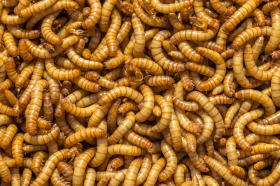Could Mealworms Help Solve our Styrofoam Waste Problem?

Plastic waste is out of control in this country, and Styrofoam is one of the worst offenders. Americans toss out 25 billion Styrofoam cups each year. Over two million tons of the stuff ends up in landfills, where it does not biodegrade. Scientists think they may have found a solution for our Styrofoam problem, though: feed it to the worms!
Partnering with researchers in China, Stanford University engineers have made a significant discovery: mealworms love to eat polystyrene. Also called Styrofoam, polystyrene is actually poisonous to some animals, so the fact that mealworms can eat a diet exclusively of the plastic is especially astounding.
While this diet doesn’t sound remotely healthy for the worms, researchers have yet to identify any adverse effects. In comparison studies, mealworms that ate exclusively Styrofoam were equally as healthy as those that a more standard diet of bran. Researchers are currently in the process of verifying that families of worms that consume only plastic are still healthy generations from now. Additionally, they want to confirm that predators that eat mealworms remain healthy after consuming worms that eat Styrofoam.
After digesting the plastic, the worm turns half of the Styrofoam into carbon dioxide, but that’s true of any type of meal mealworms eat. The other half gets released in the form of tiny non-toxic poop pellets. In all tests so far, the waste has been safe to be used as fertilizer to grow crops.
“There’s a possibility of really important research coming out of bizarre places,” said Stanford Professor Craig Criddle. “Sometimes, science surprises us. This is a shock.”
Though scientists have discovered that mealworms can thrive off Styrofoam, they’re still not entirely sure how that’s possible. Specifically, they’d like to learn what combination of bacteria is in the mealworm’s stomach that allows them to digest this material. If they could recreate that environment, they could perhaps find a safe way to quickly break down this type of plastic.
Indeed, it would be much more practical to replicate the worm’s microorganisms to tackle waste than to literally enlist mealworms for that job. Given that the small worms can only eat about 35 milligrams of Styrofoam each day, we’d need millions and millions of worms just to begin to handle the waste.
Clearly, and by the Stanford researchers’ own admission, many more experiments need to be conducted before an effective, practical solution can be reached. Still, the fact that mealworms can break down a plastic humans have never figured out how to biodegrade on our own is an exciting prospect.
Copyright © 2015 Care2.com, inc. and its licensors. All rights reserved